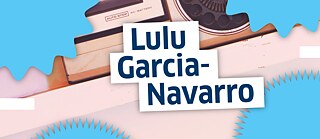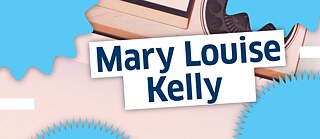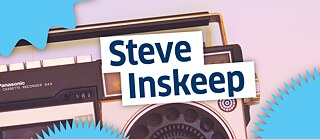Zeitgeister On Air Radio Around the World #3 with Lulu Garcia-Navarro

Longtime NPR presenter Lulu Garcia-Navarro now produces the New York Times Opinion podcast “First Person”. In this interview she tells Dina Elsayed how she ended up in radio, and what challenges are currently faced by the 100-year-old medium in her view – for example competition with TikTok, or the fact that consumer habits have shifted to on-demand media consumption.
Subscribe: Apple Podcasts | Spotify | RSS
Transkript
[Music]
Dina Elsayed: Welcome to Radio Around the World brought to you by Goethe-Institut. I’m your host, Dina Elsayed, of Common Ground Berlin. My guest today is Lulu Garcia-Navarro. She describes herself as an ‘audio journalist.’ But the award-winning former host of NPR’s Weekend Edition Sunday, who was a long time-foreign correspondent for the US Public Radio Network, is so much more. The 52-year-old has more recently taken her passion for audio to the opinion section of The New York Times. I asked Lulu about her childhood.
Lulu Garcia-Navarro: I was born in London, and I grew up in Miami, Florida. We are of Cuban and Panamanian descent. My family left Cuba during the revolution in 1959, and they became essentially political refugees. We’re six kids and we’re all born in different countries. And I think I always tell this story because it’s about basically how a, sort of, diaspora spread across the world when you kind of lose your home. And so, my siblings were born, one in Cuba, one in Panama, I was born in London, I have another sibling that was born in Spain, another one in Florida – so we kind of are the map of our family’s journey.
Dina Elsayed: Did radio play a role in your life growing up in all of these places?
Lulu Garcia-Navarro: No, radio didn’t. You know, radio is a big part of Miami and Cuban culture in Miami, so Radio Martí, you know, other sort of radio stations where you’d get political news – but I was too young for all that. I mean, I would definitely hear it and absorb it, but it wasn’t a part of my life because I grew up in the Gen X era where all of a sudden you had Walkmans. And like all young people, I was more interested in the new than the thing that was already there. So sure, we would listen to the radio in the car, but I didn’t grow up absorbing news, for example, and journalism from the radio, even though my family members did. And it was definitely a part of the fabric of my life, but it wasn’t anything that I knew anything about.
Dina Elsayed: What about your daughter today, does she listen to radio or does radio play a role in her life?
Lulu Garcia-Navarro: Well, she has to listen to the radio because we listen to the radio. Still, in the car we listen to NPR, which is my former employer. And so, she finds it super boring and she has told me that on numerous occasions. There is a whole culture of the ‘backseat child’ who is forced to listen to public radio in the United States and then grows up to be a radio lover and an informed citizen of the world – that has yet to be my experience with my 10-year-old daughter. She likes all the things that kids her age like – which is YouTube, which is TikTok. She is a visual person and so she absorbs information that way.
Dina Elsayed: And why did you become a radio journalist?
Lulu Garcia-Navarro: It’s an interesting story because it wasn’t by design. I ended up in London again after I finished university in the United States. And I was at loose ends. I didn’t know what I wanted to do. I was working at an advocacy organization and I spent a lot of my time in that advocacy organization trying to get things in the news. And so, I realized that actually I was less interested in advocating for things to be in the news – I was more interested in being in the news business myself. And I didn’t know how to go about doing that and so I ended up going back to school. And in the United Kingdom there is a wonderful school called City University, which has sort of the premier journalism program. And it’s a one-year program. Unlike in the United States it’s a vocational program – in the United Kingdom, journalism is seen less in the lofty ways that it’s seen in the United States and more, just as something you have to learn like a journeyman. And that really appealed to me. But they didn’t have a television program, which is what I was actually interested in. So, I ended up going to City University in London and going to journalism school. And I was interested in broadcast. But they did not have a television studio or television program – they had radio. And I had never thought of radio. Radio was not a thing in sort of journalism schools in the United States, which I’d also been looking at while I was considering embarking on a career in journalism. But the United Kingdom had this wonderful history of audio journalism – started, of course, by the BBC. And I was interested in international journalism. I’d spent sort of a couple years traveling around after I graduated university teaching English in Asia and Latin America. And so, I was really interested in international journalism. And the BBC just, all of a sudden, was like this incredible organization that I had not really thought about in that way. I listened to radio in the United Kingdom. I listened to Radio 4, I listened to the World Service. But I hadn’t thought about it as a career or a craft. And then all of a sudden, I ended up going to this school, which only had radio. And I just fell in love. I fell in love immediately.
Dina Elsayed: Lulu, you are an award-winning broadcaster who spent more than two decades covering conflicts on four continents. Is radio reporting difficult in a war zone? And what are the advantages and disadvantages to covering wars on and for radio?
Lulu Garcia-Navarro: Yeah, you know, it’s interesting you keep on using the word radio – you know, now we use audio because, of course, the world of audio journalism, which encompasses radio journalism, has become so vast with podcasts really kind of coming to the forefront. But, of course, when I got started, I was doing radio journalism. And that was really the only way to get audio journalism into the ears of people. And it was complicated in the beginning. Just getting your audio back to where it would be broadcast was a very old-fashioned system. You know, this was the age of satellites. And for TV, you would feed your images through satellite broadcasts. But for audio, that just wasn’t the case. And so, you still had these weird phone systems where you’d plug in your recorder to the landline through a doohickey and sort of feed it down the line. And the quality wasn’t very good. You know, you were sometimes just literally kind of phoning in reports. And so the quality was variable. You had to be very ingenious in the way that you kind of got your product back to the headquarters. But I always loved it because you could have real conversations with people in a way that was immediate. So not like print, where you’re just sitting there with a notebook, and you’re not necessarily capturing the immediacy of the environment. And it’s not as intrusive as a camera, where all of a sudden, you know, you have a camera in someone’s face, and there’s usually a producer there, holding a microphone, and then there’s the journalist asking the questions … it’s very hard, especially in conflict areas for people to not think about a camera. But I found when you just have a microphone – and I would hide my recorder often, and I would use quite a small microphone – you could have that intimacy. They could forget for a moment that you had a microphone in their face. And you could interact human to human. I think that that gave a real richness to the kind of audio that I was able to capture the places that I was able to get into, where other people might not have been able to get into. And the ability to really capture a moment through sound, that really I think makes audio just really special – especially in war zones.
Dina Elsayed: Do you have a favorite or most memorable radio or audio story that you can share with us?
Lulu Garcia-Navarro: Wow … I’ve done a lot of stories. And as I get older, I reorder the things that I think are important – because what you sometimes think was really important while you were doing it, becomes less important in hindsight, or history will show it to be less important. So, I would say going to the Amazon Rainforest – documenting that destruction firsthand. It sounds now kind of funny that you would think at the time that maybe it wasn’t a super important story, but I had to really fight to get that story and series on air. And it got a lot of awards, but at the time, you know, it just felt like, “Yeah, okay, the Amazon Rainforest – whatever.” And I think when I was younger, it felt like all the wars that I was covering were the most important things that I could possibly be covering, because “What could be more important than war?” And now that I’ve done so many of them, and I see how quickly nations, invading nations, and the media that follows them move on from those conflicts, I would say that maybe that’s less of an important legacy.
Dina Elsayed: Lulu, you are a strong supporter of diversity and feminism. Do radio and audio journalists and networks do enough to reach those audiences? Why or why not?
Lulu Garcia-Navarro: No, no, I don’t think they do. I think it’s an existential crisis. But I think, you know, the real problem here is that the media and journalism writ large is actually in a profound moment of collapse. If you look at what is happening, you’re going to see that radio itself, how people get their news, audio journalism, journalism with just a full stop – there is no, at the moment, viable, sustainable, thriving business model that makes this work. And so, what the heads of news organizations will tell you often is that it is imperative to bring in the next generation, and that is a more diverse generation, and that the reason that we’re not thriving is that we failed from engaging these audiences; we betrayed them in some ways, we’ve ignored them in some ways, and that’s because many of the newsrooms historically have been white and overwhelmingly male. I will say that that is changing, that has changed in the last decade. I am proof of that. The problem is that it’s too late. I think it’s too late now. Fundamentally, the younger generation doesn’t trust us, has moved on to getting their information in a different way. And I think that we need to figure out a better way to meet the next generation where they’re at – because they’re getting their news from TikTok now, from people who aren’t journalists, who aren’t trained to be journalists, who don’t even understand what it means to be a journalist. And so we have done a very poor job of explaining that you need fact checking, that you need a different set of eyes on what you’re putting out into the world, and the value of that, and why it matters to have factual information. I mean, we’re losing the information war, and we are the purveyors of information.
Dina Elsayed: You left the radio industry, or NPR, to join The New York Times opinion podcast team, where you’ve done some amazing interviews – like the one with the American special education teacher who was thinking about carrying a gun in her classroom. Do you think radio will be replaced by podcasting or other on-demand mediums?
Lulu Garcia-Navarro: I think it has been. I think it has been. I think the radio listenership is declining dramatically where a lot of people do their listening is in cars. We saw that during the pandemic, where, for example, the most robust radio network for news in the United States, which is NPR, saw declines of 30 percent, which is unprecedented – unprecedented in the history of the medium. And so, it’s a moment where everyone is trying to figure out how to get terrestrial radio to matter in the way that it has before. And I think many people will tell you that it just won’t. And they are desperately trying to figure out what comes next, because the problem with on-demand – and we’re seeing this, by the way, in every single space: we’re seeing this in streaming for the big networks and for the movie studios, we’re seeing this in print and the move to digital … the problem with on-demand is that, again, it’s very difficult to monetize, it’s very difficult to capture the audience. The reason that radio works and has worked for so long is that you have, in a way, a captive audience that is in a car, or might be doing something at home – and that is the way that they’re going to be receiving information. And once you allow that to kind of spread out to being able to use your phone and being able to use your smart speaker, and there’s all these different ways of getting the audio experience. You’re no longer going to have that audience. And that audience is also going to be like, “Hey, why am I going to do this when I can also do that?” They have a lot of things competing for their attention. So what the radio networks have found themselves with, they’re not only just competing now with other radio networks, they’re not even competing anymore with podcasts and that experience. They’re competing with Netflix, they’re competing with YouTube, they’re competing with everything, if you think on a typical day, that vies for our attention. And so it’s hard, it’s a hard moment, I think, because I do think we’re seeing the demise of the terrestrial radio experience.
Dina Elsayed: You were Weekend Edition Sunday’s host for four years – the first Latina host, if I’m not mistaken, that NPR had. Do you miss hosting?
Lulu Garcia-Navarro: I sure do. Of course I do. I think there’s nothing like it. There’s a real buzz that comes with having a live experience where it’s you and the microphone and millions of people tuning in. And I want to be clear, NPR’s audience is still vast and huge. If you think a successful podcast normally has listenership in the hundreds of thousands – NPR still pulls in millions of people to listen to it all the time. I think the joy of live broadcasting is unparalleled. I don’t miss the clock. You know, in live broadcasting we are tied to this clock that ticks. And all of a sudden you run out of time, and it doesn’t matter where you are in an interview, or how good that interview is, or if that person is about to tell you the most amazing thing – when the clock goes to zero, you’re out. And so there is a real kind of excitement to that. There’s a real power to that. But having moved into the on-demand audio space, I have to say there’s a real pleasure to be able to just make an interview as long as it needs to be, as opposed to fitting into that, you know, the tyranny of the clock. But by the same token as a host, you know, that’s where your skill comes in. You know, you have to be quick, you have to be incisive, you have to learn how to move a guest on from something that might be boring to something that might be more interesting to the listener. So, you learn a lot being a live host in a way that is, you know, really, really empowering.
Dina Elsayed: That was Lulu Garcia-Navarro of The New York Times. I’m Dina Elsayed of Common Ground Berlin, and thank you for listening.
Host: Radio Around the World is brought to you by the Goethe-Institut. Thank you to all of our friends and partners for making this series possible. [Music]


